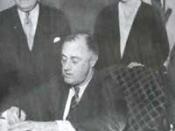Labor Relations � PAGE \* MERGEFORMAT �1�
Unions are organizations that are formed for the purpose of representing their members' interests in dealing with employers (Noe, Hollenbeck, Gerhart, & Wright, 2007, p. 459). According to the Wagner Act of 1935, employees were given the right to collectively bargain and as a result, the National Labor Relations Board was created. As a result of the National Labor Relations Act of 1935, employees have the right to self-organization, to form, to join, or to assist labor organizations, to bargain collectively through representatives of their own choosing, and to engage in other concerted activities for the purpose of collective bargaining or other mutual aid or protection, and shall also have the right to refrain from any or all such activities [National Labor Relations Act of 1935, 29 U.S.C. ç151-169, ç157, Section 7.].
When considering organizing or joining a union, one should consider the advantages and disadvantages of unionizing along with several other factors.
Union benefits would be the primary advantage for employees to unionize. Historically, unions have been able to preserve the most important benefits for their members, while nonunion workers have not been able to deflect the huge employer push to cut wages and shift additional costs on to nonunion employees. Union employees generally have better health care and retirement benefits than nonunion workers have, and are far less likely to be forced to contribute to the cost. On the contrary, there are also some disadvantages that should be considered as it relates to joining a union. . Although the union has bargaining leverage when negotiating salary increases, some of the increase would not be realized because of the union dues. Another disadvantage of joining a union is the risk of a strike. When it is time to renegotiate...


